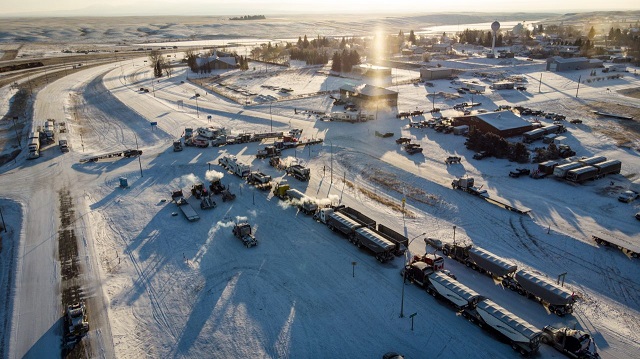Alberta
‘Coutts Two’ Verdict: Bail and Mischief

Protesters demonstrating against COVID-19 mandates and restrictions gather as a truck convoy blocks the highway at the Canada-U.S. border crossing in Coutts, Alta., on Feb. 2, 2022. The Canadian Press/Jeff McIntosh
From the Frontier Centre for Public Policy
By Ray McGinnis
Imagine spending over two years behind bars, only to be told the evidence never supported the charges against you.
On Aug. 2, a Lethbridge jury found Chris Carbert and Tony Olienick not guilty of the most serious charge of conspiracy to commit murder of police officers. However, though they were declared innocent, the conspiracy charge was the basis for their being held in remand for at least 925 days. They were denied bail based on this charge.
The sentencing hearing for other charges against Carbert and Olienick is taking place this week.
Granting Bail Typical for Serious Offences
In Canada, when someone is charged with committing a crime, they’re released on bail. This includes those charged with murder. For example, in September 2021, 31-year-old Umar Zameer was released on bail after being charged with the first-degree murder of Toronto Police Constable Jeffrey Northrup.
A case of double murder in the city of Mission in B.C.’s Fraser Valley concerned the deaths of Lisa Dudley and her boyfriend Guthrie McKay. Tom Holden, accused of first-degree murder in the case, was released on bail.
Conditions for not Granting Bail
Why do we release people from custody after being charged with a crime? Why don’t we hold people indefinitely? It’s been a Canadian tradition that there’s a process in place to which we adhere. Does the person charged with a crime seem to present a risk of repeating an offence? Carbert and Olienick hadn’t previously committed the offence(s) they were charged with. They didn’t have any criminal records for any violence. So, the likelihood of repetition of offence didn’t apply.
Another reason for denying bail is flight risk. But the Crown agreed neither of these men posed a flight risk. If you’re not clear about the identity of the person you’ve arrested, you can hold them in custody. But the Crown and the RCMP were certain of the identity of these men.
How about denying bail for evidence protection? If let go, was it possible the Crown or RCMP would lose evidence, and they needed to keep Carbert and Olienick in remand? No.
Were Carbert or Olienick considered a danger to the public? No. They had no past history of committing violent crimes, so in the case of the Coutts Two this was not a reason to deny bail.
The Crown insisted the pair be denied bail because their release would undermine confidence in the judicial system. Due to the seriousness of the offences the pair were charged with, releasing them would put the legal system into disrepute. But this is a circular argument. In authoritarian countries, police may arrest citizens on serious charges they’re not guilty of and leave them in prison indefinitely.
Granting Bail Goes Back to Magna Carta
Since the Magna Carta was signed in 1215, western judicial institutions have allowed those charged with a crime to be presumed innocent until proven guilty. With that provision comes the right to bail and a speedy trial. When citizens are accused of a crime and left to rot in prison without having their day in court, their spirits can be broken and persuaded to agree to plead guilty even when they are innocent.
Unindicted Co-conspirators Never Interviewed
During the trial, the Crown repeatedly named a list of unindicted co-conspirators. Each had a licence to carry a weapon in public for years. None of them were ever searched. None of them were ever interviewed. None of the alleged co-conspirators received any communication from the RCMP, or other authorities, about their possible connection to a conspiracy to murder police officers. However, the list of names provided for some legal theatre in the court added to the ominous scale of the supposed conspiracy to murder police officers.
Intelligence
Former career police officer Vincent Gircys had standing in the Justice Mosley decision. The judge ruled in January 2024 that the government’s invocation of the Emergencies Act in February 2022 to end the convoy protests was unconstitutional.
After the Coutts Two verdict, Gircys was concerned about the intelligence. There was a disconnect between the conspiracy charge and the evidence the Crown brought to trial. Gircys stated, “It’s really important to find where that disconnect is. Because of faulty intelligence? False intelligence? Fabricated intelligence? The evidence that they (RCMP) do have would all be logged, gathered, and time-lined. And that goes to what evidence was not gathered? … How could that information have been laid in the first place? How could the Crown have proceeded with this case to begin with?”
The Coutts Two were found not guilty of conspiracy to commit murder. But by the time they are sentenced on the other charges this week, they will have spent at least 925 days in custody. What does this mean for innocent until proven guilty?
Ray McGinnis is a Senior Fellow with the Frontier Centre for Public Policy. His forthcoming book is “Unjustified: The Emergencies Act and the Inquiry that Got It Wrong.”
Alberta
Alberta’s new diagnostic policy appears to meet standard for Canada Health Act compliance

From the Fraser Institute
By Nadeem Esmail, Mackenzie Moir and Lauren Asaad
In October, Alberta’s provincial government announced forthcoming legislative changes that will allow patients to pay out-of-pocket for any diagnostic test they want, and without a physician referral. The policy, according to the Smith government, is designed to help improve the availability of preventative care and increase testing capacity by attracting additional private sector investment in diagnostic technology and facilities.
Unsurprisingly, the policy has attracted Ottawa’s attention, with discussions now taking place around the details of the proposed changes and whether this proposal is deemed to be in line with the Canada Health Act (CHA) and the federal government’s interpretations. A determination that it is not, will have both political consequences by being labeled “non-compliant” and financial consequences for the province through reductions to its Canada Health Transfer (CHT) in coming years.
This raises an interesting question: While the ultimate decision rests with Ottawa, does the Smith government’s new policy comply with the literal text of the CHA and the revised rules released in written federal interpretations?
According to the CHA, when a patient pays out of pocket for a medically necessary and insured physician or hospital (including diagnostic procedures) service, the federal health minister shall reduce the CHT on a dollar-for-dollar basis matching the amount charged to patients. In 2018, Ottawa introduced the Diagnostic Services Policy (DSP), which clarified that the insured status of a diagnostic service does not change when it’s offered inside a private clinic as opposed to a hospital. As a result, any levying of patient charges for medically necessary diagnostic tests are considered a violation of the CHA.
Ottawa has been no slouch in wielding this new policy, deducting some $76.5 million from transfers to seven provinces in 2023 and another $72.4 million in 2024. Deductions for Alberta, based on Health Canada’s estimates of patient charges, totaled some $34 million over those two years.
Alberta has been paid back some of those dollars under the new Reimbursement Program introduced in 2018, which created a pathway for provinces to be paid back some or all of the transfers previously withheld on a dollar-for-dollar basis by Ottawa for CHA infractions. The Reimbursement Program requires provinces to resolve the circumstances which led to patient charges for medically necessary services, including filing a Reimbursement Action Plan for doing so developed in concert with Health Canada. In total, Alberta was reimbursed $20.5 million after Health Canada determined the provincial government had “successfully” implemented elements of its approved plan.
Perhaps in response to the risk of further deductions, or taking a lesson from the Reimbursement Action Plan accepted by Health Canada, the province has gone out of its way to make clear that these new privately funded scans will be self-referred, that any patient paying for tests privately will be reimbursed if that test reveals a serious or life-threatening condition, and that physician referred tests will continue to be provided within the public system and be given priority in both public and private facilities.
Indeed, the provincial government has stated they do not expect to lose additional federal health care transfers under this new policy, based on their success in arguing back previous deductions.
This is where language matters: Health Canada in their latest CHA annual report specifically states the “medical necessity” of any diagnostic test is “determined when a patient receives a referral or requisition from a medical practitioner.” According to the logic of Ottawa’s own stated policy, an unreferred test should, in theory, be no longer considered one that is medically necessary or needs to be insured and thus could be paid for privately.
It would appear then that allowing private purchase of services not referred by physicians does pass the written standard for CHA compliance, including compliance with the latest federal interpretation for diagnostic services.
But of course, there is no actual certainty here. The federal government of the day maintains sole and final authority for interpretation of the CHA and is free to revise and adjust interpretations at any time it sees fit in response to provincial health policy innovations. So while the letter of the CHA appears to have been met, there is still a very real possibility that Alberta will be found to have violated the Act and its interpretations regardless.
In the end, no one really knows with any certainty if a policy change will be deemed by Ottawa to run afoul of the CHA. On the one hand, the provincial government seems to have set the rules around private purchase deliberately and narrowly to avoid a clear violation of federal requirements as they are currently written. On the other hand, Health Canada’s attention has been aroused and they are now “engaging” with officials from Alberta to “better understand” the new policy, leaving open the possibility that the rules of the game may change once again. And even then, a decision that the policy is permissible today is not permanent and can be reversed by the federal government tomorrow if its interpretive whims shift again.
The sad reality of the provincial-federal health-care relationship in Canada is that it has no fixed rules. Indeed, it may be pointless to ask whether a policy will be CHA compliant before Ottawa decides whether or not it is. But it can be said, at least for now, that the Smith government’s new privately paid diagnostic testing policy appears to have met the currently written standard for CHA compliance.

Lauren Asaad
Policy Analyst, Fraser Institute
Alberta
Alberta Next Panel calls to reform how Canada works

From the Fraser Institute
By Tegan Hill
The Alberta Next Panel, tasked with advising the Smith government on how the province can better protect its interests and defend its economy, has officially released its report. Two of its key recommendations—to hold a referendum on Alberta leaving the Canada Pension Plan, and to create a commission to review programs like equalization—could lead to meaningful changes to Canada’s system of fiscal federalism (i.e. the financial relationship between Ottawa and the provinces).
The panel stemmed from a growing sense of unfairness in Alberta. From 2007 to 2022, Albertans’ net contribution to federal finances (total federal taxes paid by Albertans minus federal money spent or transferred to Albertans) was $244.6 billion—more than five times the net contribution from British Columbians or Ontarians (the only other two net contributors). This money from Albertans helps keep taxes lower and fund government services in other provinces. Yet Ottawa continues to impose federal regulations, which disproportionately and negatively impact Alberta’s energy industry.
Albertans were growing tired of this unbalanced relationship. According to a poll by the Angus Reid Institute, nearly half of Albertans believe they get a “raw deal”—that is, they give more than they get—being part of Canada. The Alberta Next Panel survey found that 59 per cent of Albertans believe the federal transfer and equalization system is unfair to Alberta. And a ThinkHQ survey found that more than seven in 10 Albertans feel that federal policies over the past several years hurt their quality of life.
As part of an effort to increase provincial autonomy, amid these frustrations, the panel recommends the Alberta government hold a referendum on leaving the Canada Pension Plan (CPP) and establishing its own provincial pension plan.
Albertans typically have higher average incomes and a younger population than the rest of the country, which means they could pay a lower contribution rate under a provincial pension plan while receiving the same level of benefits as the CPP. (These demographic and economic factors are also why Albertans currently make such a large net contribution to the CPP).
The savings from paying a lower contribution rate could result in materially higher income during retirement for Albertans if they’re invested in a private account. One report found that if a typical Albertan invested the savings from paying a lower contribution rate to a provincial pension plan, they could benefit from $189,773 (pre-tax) in additional retirement income.
Clearly, Albertans could see a financial benefit from leaving the CPP, but there are many factors to consider. The government plans to present a detailed report including how the funds would be managed, contribution rates, and implementation plan prior to a referendum.
Then there’s equalization—a program fraught with flaws. The goal of equalization is to ensure provinces can provide reasonably comparable public services at reasonably comparable tax rates. Ottawa collects taxes from Canadians across the country and then redistributes that money to “have not” provinces. In 2026/27, equalization payments is expected to total $27.2 billion with all provinces except Alberta, British Columbia and Saskatchewan receiving payments.
Reasonable people can disagree on whether or not they support the principle of the program, but again, it has major flaws that just don’t make sense. Consider the fixed growth rate rule, which mandates that total equalization payments grow each year even when the income differences between recipient and non-recipient provinces narrows. That means Albertans continue paying for a growing program, even when such growth isn’t required to meet the program’s stated objective. The panel recommends that Alberta take a leading role in working with other provinces and the federal government to reform equalization and set up a new Canada Fiscal Commission to review fiscal federalism more broadly.
The Alberta Next Panel is calling for changes to fiscal federalism. Reforms to equalization are clearly needed—and it’s worth exploring the potential of an Alberta pension plan. Indeed, both of these changes could deliver benefits.
-

 Alberta2 days ago
Alberta2 days agoAlberta’s huge oil sands reserves dwarf U.S. shale
-

 Energy2 days ago
Energy2 days agoCanada’s sudden rediscovery of energy ambition has been greeted with a familiar charge: hypocrisy
-

 armed forces2 days ago
armed forces2 days agoOttawa’s Newly Released Defence Plan Crosses a Dangerous Line
-

 Alberta2 days ago
Alberta2 days agoCanada’s New Green Deal
-

 Business2 days ago
Business2 days agoCOP30 finally admits what resource workers already knew: prosperity and lower emissions must go hand in hand
-

 Business2 days ago
Business2 days agoOttawa Pretends To Pivot But Keeps Spending Like Trudeau
-

 Agriculture7 hours ago
Agriculture7 hours agoWhy is Canada paying for dairy ‘losses’ during a boom?
-

 Indigenous2 days ago
Indigenous2 days agoResidential school burials controversy continues to fuel wave of church arsons, new data suggests









